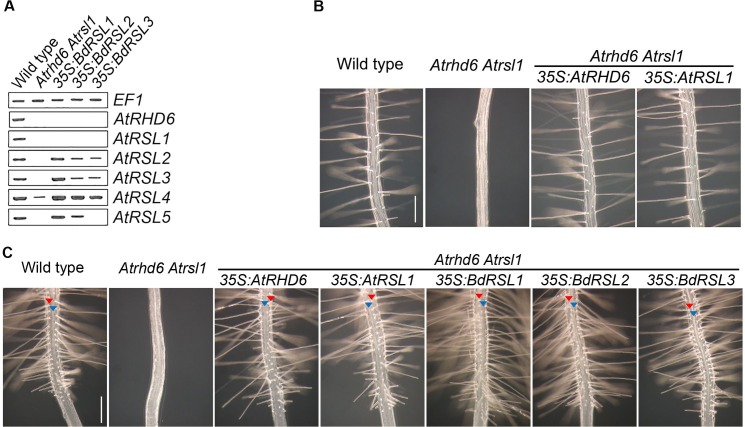There is an error in Fig 5C. The image for the Atrhd6 Atrsl1 35:BdRSL1 root is duplicated and appears as the image for the Atrhd6 Atrsl1 35:AtRSL1 root. Please view the correct Fig 5 here, with the correct image for the Atrhd6 Atrsl1 35:AtRSL1 root.
Fig 5. The function B. distachyon and A. thaliana RSL class I genes is conserved.
(A) Steady state levels of AtRSL class I and class II mRNA in Atrhd6 Atrsl1 double mutants, and in Atrhd6 Atrsl1 double mutants transformed BdRSL class I genes under the control of the 35S promoter. Lane 1: wild type, Lane2: Atrhd6 Atrsl1 double mutant, Lane3: Atrhd6 Atrsl1 35S:BdRSL1, Lane4: Atrhd6 Atrsl1 35S:BdRSL2, Lane5: Atrhd6 Atrsl1 35S:BdRSL3. (B) Phenotype of wild type; Atrhd6 Atrsl1 double mutant; Atrhd6 Atrsl1 35S:AtRHD6; Atrhd6 Atrsl1 35S:AtRSL1. Scale bar 200 μm. (C) Files of root hair cells and hairless epidermal cells form in wild-type, Atrhd6 Atrsl1 35S:AtRHD6, Atrhd6 Atrsl1 35S:AtRSL1, Atrhd6 Atrsl1 35S:BdRSL1, Atrhd6 Atrsl1 35S:BdRSL2 and Atrhd6 Atrsl1 35S:BdRSL3. Atrhd6 Atrsl1 double mutants do not develop root hairs. Red arrowhead indicates a hair cell file, blue arrowhead indicates the position of a hairless epidermal cell file. Scale bar 200 μm.
Reference
- 1.Kim CM, Dolan L (2016) ROOT HAIR DEFECTIVE SIX-LIKE Class I Genes Promote Root Hair Development in the Grass Brachypodium distachyon. PLoS Genet 12(8): e1006211 doi:10.1371/journal.pgen.1006211 [DOI] [PMC free article] [PubMed] [Google Scholar]



